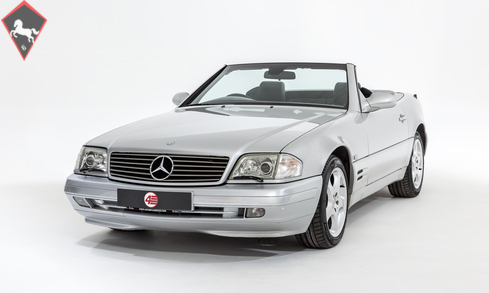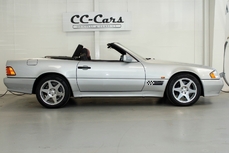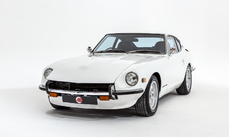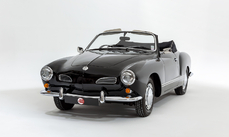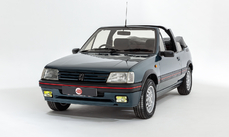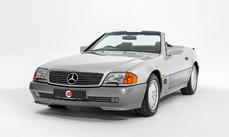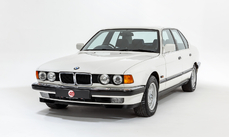Mercedes-Benz SL320 r129 SL320 2000
General description :
Equipment
Brilliant Silver Metallic paintwork, Black Nappa leather upholstery, 17-inch 5-spoke alloy wheels, 5-speed automatic transmission, Panoramic hardtop with stand, Electric-folding soft top in black, Xenon headlights, Heated electric front seats, Electric folding door mirrors, Digital climate control AC, Electrically-adjustable steering column, Burr walnut wood trim, Rear seats, Spare wheel, Removable wind deflector, Mercedes certificate of conformity, Mercedes data card.
Exterior
Finished in timeless Brilliant Silver Metallic this facelift V6 SL presents very nicely indeed. After a machine polish by our in-house detailer the paintwork is bright and glossy all round with no bubbling on any of the arches. There are a few discreetly touched-in marks to note on close inspection but it’s straight along both sides and all the lights are clear and damage-free. The car was spec’d from new with the desirable panoramic hardtop option and the original 5-spoke alloy wheels are also still fitted. Not a concours example but a very tidy facelift R129 in great usable condition. VIEWINGS WELCOME BY APPOINTMENT ONLY /// ADDITIONAL PHOTOS AND VIDEOS AVAILABLE UPON REQUEST
Interior
The sumptuous SL interior is a wonderful place to be. The seats are trimmed in soft Nappa leather with the upholstery remaining in excellent condition. The glossy walnut centre console trim is also in good order with no cracks to the lacquer. Equipment-wise this SL sports a number of creature comforts including digital climate control AC (blowing ice cold having just been re-gassed), heated and electric front seats, cruise control, an electric steering column, electric folding door mirrors, Xenon headlights, and Bluetooth/USB connectivity from the upgraded Blaupunkt head unit.
ENGINE & TRANSMISSION
The SL has just returned from a full check over and service at the current mileage of 103k. Requiring little more than an oil change and air con re-gas the car drives really well, with effortless V6 performance and near-seamless gear changes from the 5-speed automatic box. A new battery was fitted in May 2024 and the brake pads were replaced all round less than 2k miles ago.
History File
This charming SL320 was supplied new in March 2000. It’s accompanied by a great service record with a fully stamped original service book and a thick raft of invoices further verifying the car’s maintenance history since new. The original Mercedes-Benz document wallet and handbooks are also on file along with the factory data card, Certificate of Conformity, a selection of past MOT certificates, and a fresh HPI report. The service history is as follows:
10/11/2000 at 13,498 miles06/07/2001 at 25,659 miles24/04/2002 at 38,580 miles13/03/2003 at 45,280 miles08/04/2004 at 55,575 miles18/05/2007 at 63,394 miles22/12/2009 at 69,291 miles04/01/2013 at 74,514 miles16/04/2015 at 79,083 miles21/09/2017 at 83,642 miles18/04/2019 at 86,762 miles03/08/2020 at 96,128 miles09/02/2022 at 101,570 miles17/10/2024 at 103,427 miles
2000 Mercedes-Benz SL320 r129 SL320 is listed for sale on ClassicDigest in Hampshire by 4Star Classics for £10495.
Car Facts
Car type : Car Make : Mercedes-Benz Model : SL320 r129 Model Version : SL320 Engine size : 3.2 Model Year : 2000 Sub type : Coupé Location : Hampshire Vehicle Registration : Undefined
10495 £
People who viewed this Mercedes-Benz SL320 r129 also viewed similar Mercedes-Benz listed at ClassicDigest
Other cars listed for sale by this dealer
About Mercedes-Benz
In the annals of automotive history, the journey of Mercedes-Benz is a tale that unfolds with the ingenuity of its founding pioneers. In the year 1886, Karl Benz crafted the Benz Patent Motorwagen, a creation that would go down in history as the world's inaugural automobile. Unbeknownst to him, this moment marked the genesis of what would evolve into the most illustrious premium car manufacturer globally. The financial underpinning of this pioneering venture, interestingly, was provided by Karl Benz's wife, Bertha Benz, demonstrating a remarkable partnership that would set the tone for Mercedes-Benz's legacy.A parallel narrative emerged not far away, as Daimler-Motoren-Gesellschaft, founded by Gottlieb Daimler and Wilhelm Maybach, entered the scene. In 1901, they unveiled their automobile under the now-famous moniker "Mercedes," meaning "godsend" in Spanish. This name was bestowed upon the car at the behest of Emil Jellinek's daughter, the distributor for Daimler-Motoren-Gesellschaft. The wheels of innovation were set in motion.
Fast forward to 1926, a pivotal year that witnessed the merger of Daimler with Benz & Cie., culminating in the birth of Daimler-Benz. The amalgamation saw the adoption of "Mercedes-Benz" as the distinguished trademark for their automobiles, fusing the legacies of two visionary entities into one.
Contrary to perceptions of conservatism, the trajectory of Daimler-Benz unfolds as a chronicle of industry firsts. From the introduction of the honeycomb radiator to the float carburetor, and the pioneering implementation of four-wheel brakes in 1924, Daimler-Benz consistently pushed the boundaries of automotive innovation. The diesel-powered Mercedes-Benz 260 D in 1936 marked the inception of diesel engines in passenger cars. The iconic Mercedes-Benz 300SL Gullwing made history as the first car with direct fuel injection, albeit the Gutbrod's tiny 2-stroke engine can claim precedence.
Safety innovations became a hallmark, with Béla Barényi's patented safety cell design in the "Ponton"-models in 1951, featuring front and rear crumple zones. The W116 450SEL 6.9 saw the introduction of the Anti-Lock Brake system (ABS), another pioneering safety feature. From the first production airbags and beyond, the legacy of "firsts" continued to be etched into the fabric of Daimler-Benz.
Over its centennial journey, Mercedes-Benz has not merely produced cars but has sculpted automotive icons. The SSKL, 710 SSK Trossi Roadster, 770K Grosser, 540K Spezial Roadster, 300SL Gullwing, w100 600 Pullman, w111 280SE 3.5 Flachkühler, w113 230SL Pagoda, w109 300 SEL 6.3, and w201 2.3-16 Cosworth stand testament to the brand's commitment to engineering excellence.
The roaring Silver Arrows, or "Silberpfeile," including the W 25, W 125, W154, W165, and W196, created a legacy of dominance on the racetrack. These machines were not merely cars; they were expressions of precision, speed, and an indomitable spirit that left their competitors in the dust.
As Mercedes-Benz marches into the future, it does so not just as an automaker but as a custodian of a legacy, a torchbearer of innovation, and a beacon of automotive excellence. The road ahead is sure to witness the continued fusion of cutting-edge technology, timeless design, and an unwavering commitment to setting new standards in the world of automobiles.
One luminary figure who left an indelible mark was Béla Barényi, often heralded as the "father of passive safety" for his pioneering work in safety engineering. His patented safety cell design, featuring front and rear crumple zones, became a hallmark of Mercedes-Benz's commitment to occupant safety, setting new standards that reverberated throughout the automotive world.
Moving through the chronicles, the collaborative genius of Wilhelm Maybach, alongside Gottlieb Daimler, laid the foundation for Daimler-Motoren-Gesellschaft. Their innovations not only birthed the first Mercedes but established a culture of relentless pursuit of technological excellence that remains integral to Mercedes-Benz's DNA.
In the post-merger era of 1926, Ferdinand Porsche emerged as a prominent figure within Mercedes-Benz. His work on the Mercedes-Benz S-Type, a supercharged race car, garnered acclaim and set the stage for a legacy that extended far beyond the marque. Porsche's impact would later extend to his eponymous company, but his influence at Mercedes-Benz during those formative years was pivotal.
As the 20th century progressed, the legendary Rudolf Uhlenhaut emerged as a key figure. Uhlenhaut, an accomplished engineer and the driving force behind the iconic Silver Arrows, played a crucial role in Mercedes-Benz's dominance in motorsports. His engineering prowess and attention to detail were instrumental in creating some of the most formidable racing cars of the era.
In the latter half of the century, figures like Bruno Sacco, the head of design at Mercedes-Benz from 1975 to 1999, left an indelible imprint on the brand's aesthetic identity. Sacco's design philosophy, characterized by clean lines and timeless elegance, shaped iconic models like the W126 S-Class and the W201 190E, solidifying Mercedes-Benz's reputation for luxury and sophistication.
The narrative would be incomplete without acknowledging the contributions of engineers like Hans Scherenberg, whose leadership in the 1970s ushered in a new era of technological innovation at Mercedes-Benz. Scherenberg's tenure saw the development of groundbreaking technologies, including the Anti-Lock Brake system (ABS) and the introduction of airbags in production cars.
